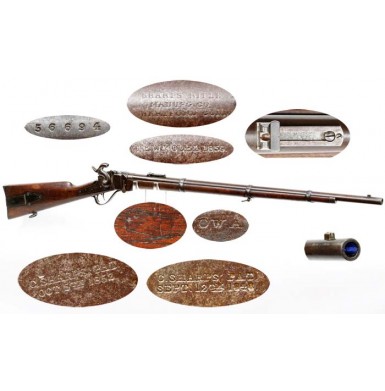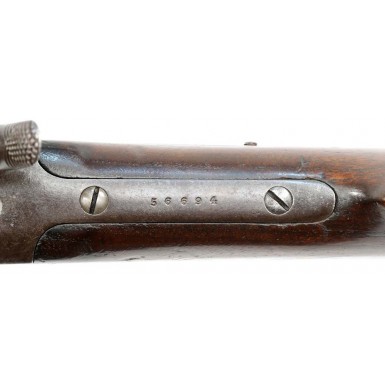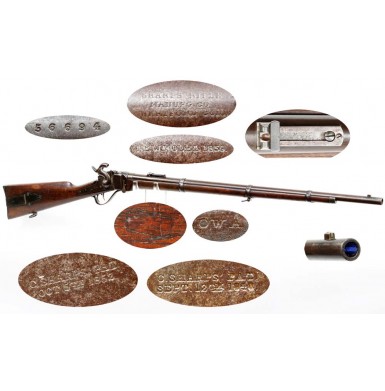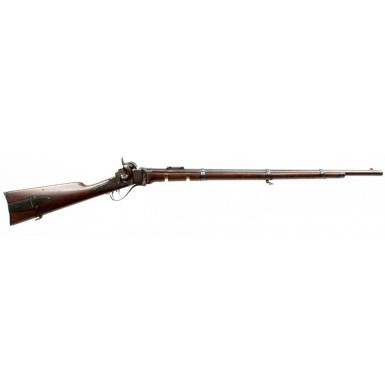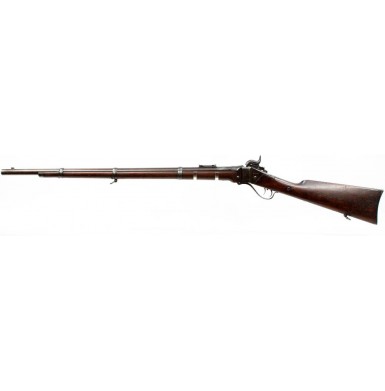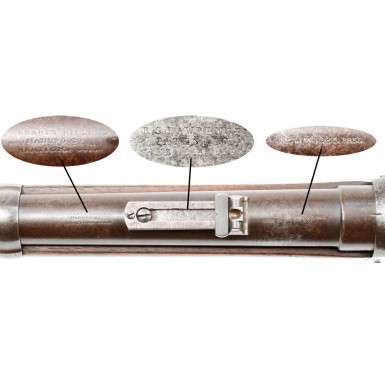For the collector of arms related to sharpshooting during the American Civil War, the ultimate acquisition is certainly an original Confederate Whitworth rifle, certainly the most iconic of long range rifles from the conflict. The second most desired weapon, and the one that is much more reasonably acquired in terms of both availability and price is a “Berdan Sharps”, one of the special order Sharps New Model 1859 Rifles issued to the 1st and 2nd US Volunteer Sharpshooters, better known as “Berdan’s Sharpshooters”, during the American Civil War. Hiram Berdan was born on September 6, 1824 in Phelps, NY. A highly-educated man, Berdan’s pre-war career was that of a mechanical engineer working in New York City. Berdan was responsible for a number of inventions ranging from a machine to separate gold from ore, a mechanical bakery, artillery fuses, a submarine gun boat, a torpedo boat, the Berdan breechloading rifle and the Berdan centerfire primer, just to name a few of his innovations. Berdan was also a target-shooting enthusiast, and when the Civil War broke out, he was the “top shot” in the United States, and had been for more than a decade. During the summer of 1861, Berdan approached the War Department with the concept of recruiting a regiment of sharpshooters, men who were outstanding marksmen, who would be deployed as special purpose troops in the conflict. In many ways, Berdan’s Sharpshooters, who would become the 1st & 2nd Regiments of US Volunteer Sharpshooters would be the first American use of organized “special forces’ type regiments, and were in many ways the 19th century predecessors to the 20th century Army Rangers and Force-Recon Marine Scout-Snipers. Berdan set relatively strict minimum standards for his marksmen. For a candidate to even be considered for the regiment, he had to be able to keep 10 shots in a 10” circle at 100 yards off-hand, and at 200 yards from a rest. Berdan also expected his men to be able to estimate distance, to be able to make adjustments to their shots to compensate for shooting up of downhill (something many modern shooters still struggle with) and to be able to adequately compensate for wind as well. While initially he requested that his men provide their own target rifles, this soon became a significant problem. Many of the guns were heavy barreled target guns weighing two to three times as much as a standard musket. Some of the guns were mounted with large and delicate optical sights that made the guns even more awkward to carry on a march. The biggest problem, however, was that each gun required its own specialized ammunition as they were not of a uniform caliber. This had to be resolved in order for the sharpshooters to be able to function effectively in the field. Berdan searched for what he felt was the perfect long arm for his “snipers’ and settled upon the Sharps New Model 1859 Rifle, with a few specialized features. The Sharps M-1859 Rifle was the invention of Christian Sharps, and was an improvement over his earlier production long arms. Sharps was born in New Jersey sometime in 1811. In 1830 Christian went to work at the famous US Armory at Harpers Ferry, under the direction of firearms inventor and interchangeable parts pioneer John Hall. Sharps worked at Harpers Ferry for over a decade, learning the arms making trade, as well as the early concepts of assembly line production. In 1848 Sharps received his first patent for a breech-loading carbine. The basis of the design would remain essentially unchanged for several decades, and would continue to be produced to this day. The simple and strong action utilized a breech block that could be lowered be “levering” the triggerguard forward. This exposed the chamber to load a cartridge. The paper or linen cartridge would then have its tail cut off by the breechblock when it was raised back into firing position, and expose the powder to the flash from the percussion cap or pellet primer that was detonated when the gun was fired. A.S. Nippes of Mill Creek, PA produced the first Sharps patent firearms in 1849 and 1850. By 1851, Sharps formed the Sharps Rifle Manufacturing Company in Hartford, CT. As the company was not yet ready to produce arms, Sharps entered into an agreement with Robbins & Lawrence of Windsor, VT to manufacture arms for him. By 1852 RS Lawrence (formerly of Robbins & Lawrence) moved to Hartford and became the master armorer of the new Sharps Rifle Manufacturing Company. The transition to the production of guns at the Sharps Rifle Manufacturing Company was rather slow, and Robbins & Lawrence produced many of the Sharps arms produced during the transition period from 1852-1856. The Sharps Rifle Manufacturing Company finally took over complete production in Hartford in October of 1856. As production of his “slant breech” series of breechloading arms continued, and were constantly improved upon, RS Lawrence came up with a solution to improving the gas seal of the breechblock. Instead of the block being set at an angle within the receiver, Lawrence proposed setting the block at right angles to the chamber. The new breechblock started appearing on some arms during 1858, but was officially patented by Lawrence in 1859, and signaled the death of the “slant breech” family of arms and issued in the “New Model” family of Sharps firearms. The New Model 1859 Rifle used this new Lawrence patented breechblock, and also featured Lawrence’s patent automated pellet priming system, which turned out to be less than effective in the field, leaving most soldiers to utilize standard percussion caps instead. According to Sharps researcher Frank Sellers, the New Model 1859 Rifle went into production in 1859 and remained in production through 1862, when it was superseded by the New Model 1863. During the approximately four years of production some 6,989 of the rifles were produced with the majority of them being purchased by the US government for military service. The rifles were serial numbered sequentially with other Sharps long arms then in production and not in their own serial number range, with the NM-1859 rifles appearing in the serial number range 36,000-60,000. The majority of these rifles were manufactured with 30” round barrels in .52 caliber, although a few were manufactured with 36” barrels and some of those were made in .56 caliber. The barrels were secured by three barrel bands, which were themselves secured by three barrel band springs in the bottom of the forend. The rifles were made with both saber bayonet lugs under the barrel and with a standard socket bayonet style combination front sight and bayonet lug. It appears that the majority of the production was designed to accept the socket (termed “angular” bayonet at that time). Berdan specified that the guns to be delivered to his men were to have double “set” triggers and were to eliminate spring loaded catch at the rear of the triggerguard plate that secured the combination triggerguard and lever in the closed position. The “set” trigger involved a second trigger (the rear most) that could be pulled to take up the majority of the trigger pull weight, leaving a very light pull of the front trigger to fire the rifle. The lightweight pull of this “hair trigger” added to the accuracy of the rifles in the hands of the trained marksmen. The balance of the rifle was pretty much a standard New Model 1859, with a blued barrel, case hardened receiver and furniture and an iron patchbox in the butt. The rifle was equipped with a pair of sling swivels, mounted on the middle barrel band and in the toe of the stock, behind the triggerguard. Research conducted by Roy Marcot indicates that the serial number range for the approximately 2,000 Berdan Sharpshooter issued rifles is from 54,374-57,514. These rifles usually have double set triggers and the omitted lever latch. Additionally, these rifles must have US sub-inspection marks and an inspection cartouche, although the marks are often well worn on rifles that saw extensive service and combat use. Due to various bureaucratic delays the Sharps rifles that Berdan desired for his regiments were not made available until the early summer of 1862, with the 1st US Sharpshooters receiving their rifles in May of that year and the 2nd US Sharpshooters receiving theirs in June. In the interim, many of the men retained their original target rifles, or were issued Colt revolving rifles, which they utilized with varied success. The 1st US Volunteer Sharpshooters mustered into service on August 1, 1861 and served for slightly less than three years, being mustered out on December 31, 1864. During that time, some 1,388 men served in their ranks, and the regiment was present for nearly every major battle and campaign of the Army of the Potomac, including the Peninsular Campaign, 2nd Manassas (Bull Run), Sharpsburg (Antietam), Chancellorsville, Gettysburg, The Wilderness, Spotsylvania, Cold Harbor and the Siege of Petersburg, just to name a few. The 2nd US Volunteer Sharpshooters were mustered into service on October 4, 1861 and remained in service through February 25 of 1865. Their record was equally storied, and the 1,132 men who served in that regiment contributed to the Army of the Potomac much as the men of the 1st USSS did, serving in the majority of the battles and campaigns listed above. The specialized nature of the regiments meant that they rarely fought as a cohesive regimental organization, but rather were often assigned to areas where they were needed on a company or even platoon level. One of the most famous efforts of the 2nd USSS was the support that some 12-15 men from that regiment provided to Company B of the 20th Maine during the defense of Little Round Top on July 2, 1863 at the Battle of Gettysburg.
Offered here is a VERY GOOD+ to NEAR FINE example of a Sharps New Model 1859 Rifle with the salient Berdan Sharpshooter features, complete with an original and correct Collins & Company Sharps Rifle Socket Bayonet. The rifle is serial number 56,694 and this number appears on both the receiver tang and on the barrel, underneath the forend. This serial number is in the second half of the accepted Berdan Sharpshooter’s range of 54,374 to 57,574. The rifle has Berdan features of double set triggers, no lever catch, the OW Ainsworth sub-inspection mark on the right barrel flat and the correct script JT cartouche on the wrist of the rifle. The rifle remains relatively well marked throughout, and even though it has clearly seen significant service and use, all of the factory-applied markings remain legible. The rear of the lock plate is marked in two lines: C. SHARPS’ PAT. / OCT. 5TH 1852 and directly behind the hammer in two lines; R.S. LAWRENCE PAT. / APRIL 12TH 1859. The reverse of the receiver is additionally marked: C. SHARPS’ PAT. / SEPT. 12TH 1848.. The top of the barrel is marked in a single line, near the receiver: NEW MODEL 1859, and in three lines forward of the rear sight: SHARPS RIFLE / MANUFG. CO / HARTFORD CONN>. The base of the rear sight is also marked in three lines, reading: R.S. LAWRENCE / PATENTED / FEB 15TH 1859. The correct OWA sub-inspection mark of O.W. Ainsworth is present on the left rear of the barrel where the barrel meets the receiver. A legible and fully visible script JT (for arsenal sub-inspector John Taylor) inspection cartouche is present on the reverse stock wrist. While this rifle is not listed specifically on any of the “known Berdan rifles’ serial number lists, those lists are certainly incomplete at best and represent a very small percentage of the approximately 2,000 Berdan rifles issued. The closest number to this rifle that I am aware of from an accepted “list” is #56736 from Wiley Sword’s list of numbers in his book Sharpshooter: Hiram Berdan, His Famous Sharpshooters and their Sharps Rifles. The rifle, as previously mentioned is in about VERY GOOD+ to NEAR FINE. It retains some minor traces of its original blued finish and has a very attractive mottled plum and brown patina over most of the metal surfaces. The rifle appears to be 100% original and correct in every way, with the exception of a single replaced screw that adjusts the set-trigger. This screw is small and delicate and is often damaged or broken, so replacement is not uncommon. As previously mentioned, the barrel and the action have matching serial numbers. The barrel shows some evenly scattered light pinpricking, as well as some lightly scattered surface oxidation scale mixed with the patina and traces of original blue. The breech block and lock shows some lightly scattered pinpricking as well, and have a mottled brown and plum patina with some scattered areas of darker mottling that appear to be traces of the original case hardened finish. The barrel bands have a medium smoky blue-gray patina with hints of their original finish, and the barrel band springs show traces of their original blued finish as well. The iron furniture has a lovely, uncleaned dark plum brown and lightly oxidized patina with some scattered light pitting and surface roughness present. The patina on the furniture matches the balance of the gun very well. The action of the rifle is fully functional, and even the delicate and somewhat temperamental double set trigger mechanism works correctly. Pulling the rear trigger fully to the rear (a short, but fairly heavy pull), sets the front trigger for a very light (and very crisp) break that feels like it weighs less than two pounds. The action of the rifle works smoothly, with lever operating the breechblock exactly as it should. The spring system for the Lawrence automated pellet primer system is in place and visible, and that system appears to be complete, but may no longer be functional. The bore of the rifle is in about FINE condition, and retains very strong, crisp rifling its entire length. The bore shows some light pinpricking scattered along its length as well as some frosting in the grooves. A good scrubbing might even improve the bore to excellent. The original 800-yard Lawrence Patent rear sight is in place on the barrel and is complete, including the elevating slider. The sight is fully functional and retains some traces of its original blued finish, mostly on the ladder and slide. All the markings on the sight remain fairly crisp and legible as well. The original front sight and socket bayonet lug remains in place near the muzzle with the original brass sight blade still present as well. What appear to be the original sling swivels are in place on the rifle, with the upper swivel attached to the middle barrel band and the lower swivel mounted on a plate in the toe of the stock. The buttstock and forend of the rifle are in about VERY GOOD+ to NEAR FINE condition as well. They both show wear and use, but remain solid with no noted breaks or repairs. Both were probably cleaned at some point in the past and but do not appear to have been sanded. The stock and forend retain good lines and edges and it appears any rounding or softening to be the result of real world wear and use. Otherwise, the stock and forend show only the expected bumps, dings and surface mars that would be expected from a 150-year-old military issue rifle, and the wood matches the look and condition of the metal perfectly.
Overall this is a very nice example of a scarce Berdan pattern Sharps New Model 1859 Rifle. The gun conforms in all ways to the usual Berdan physical requirements with set triggers and no lever lock, and has the correct inspection marks. The gun is certainly well within the range of known Berdan Sharps rifles, and is only 42 numbers away from one of the handful of “confirmed” Berdan serial numbers in print. The rifle is complete and shows real world use, but no abuse and is a very well-marked and solid example of a Berdan pattern Sharps rifle. These guns to do not appear for sale very often, and this is a much nicer example than is usually encountered, which remains very crisp, with wonderful eye appeal and a wonderful, uncleaned patina. I am quite sure that you very happy with this gun and even happier adding it to your collection.
SOLDTags: Berdan, Sharpshooters, Sharps, Rifle

